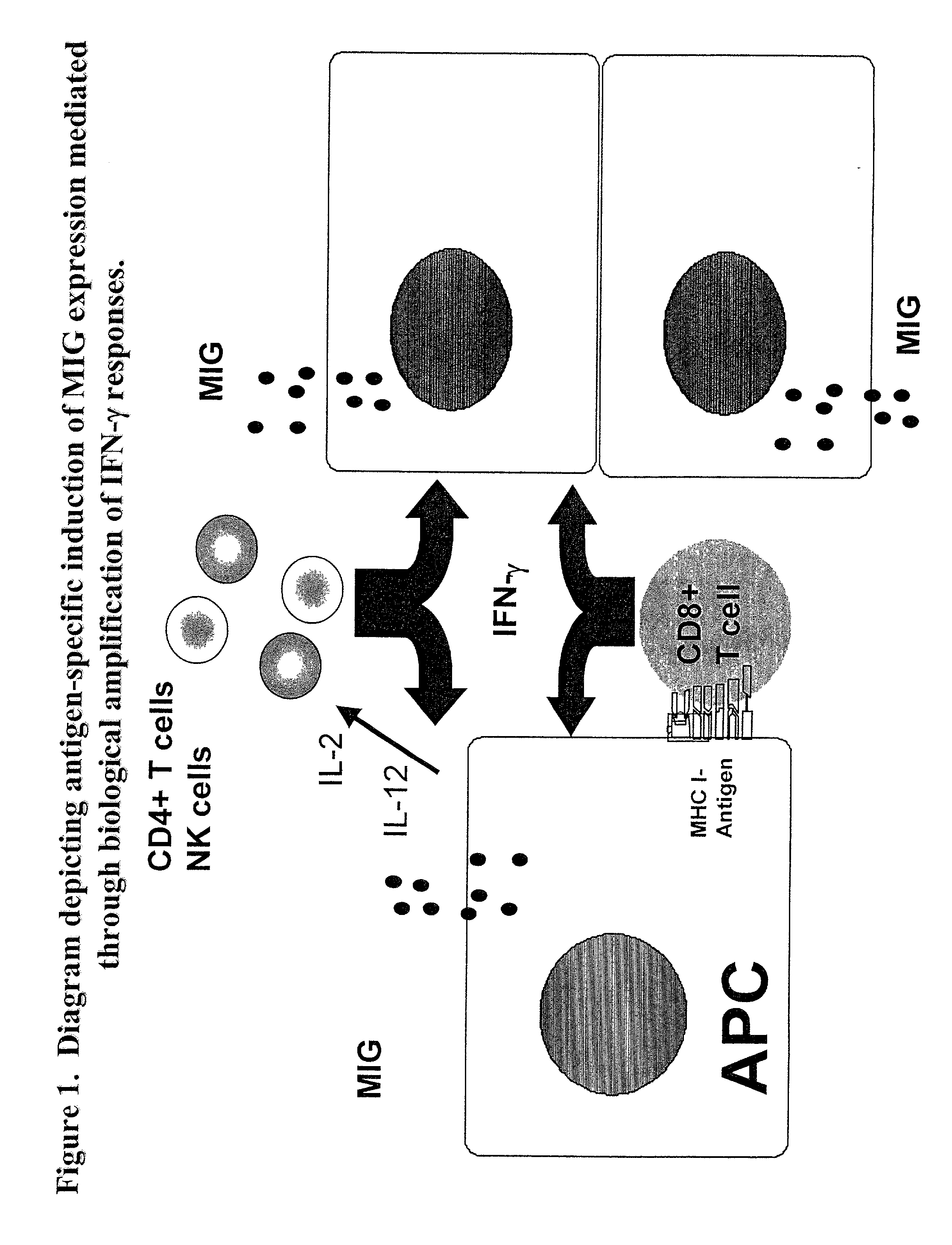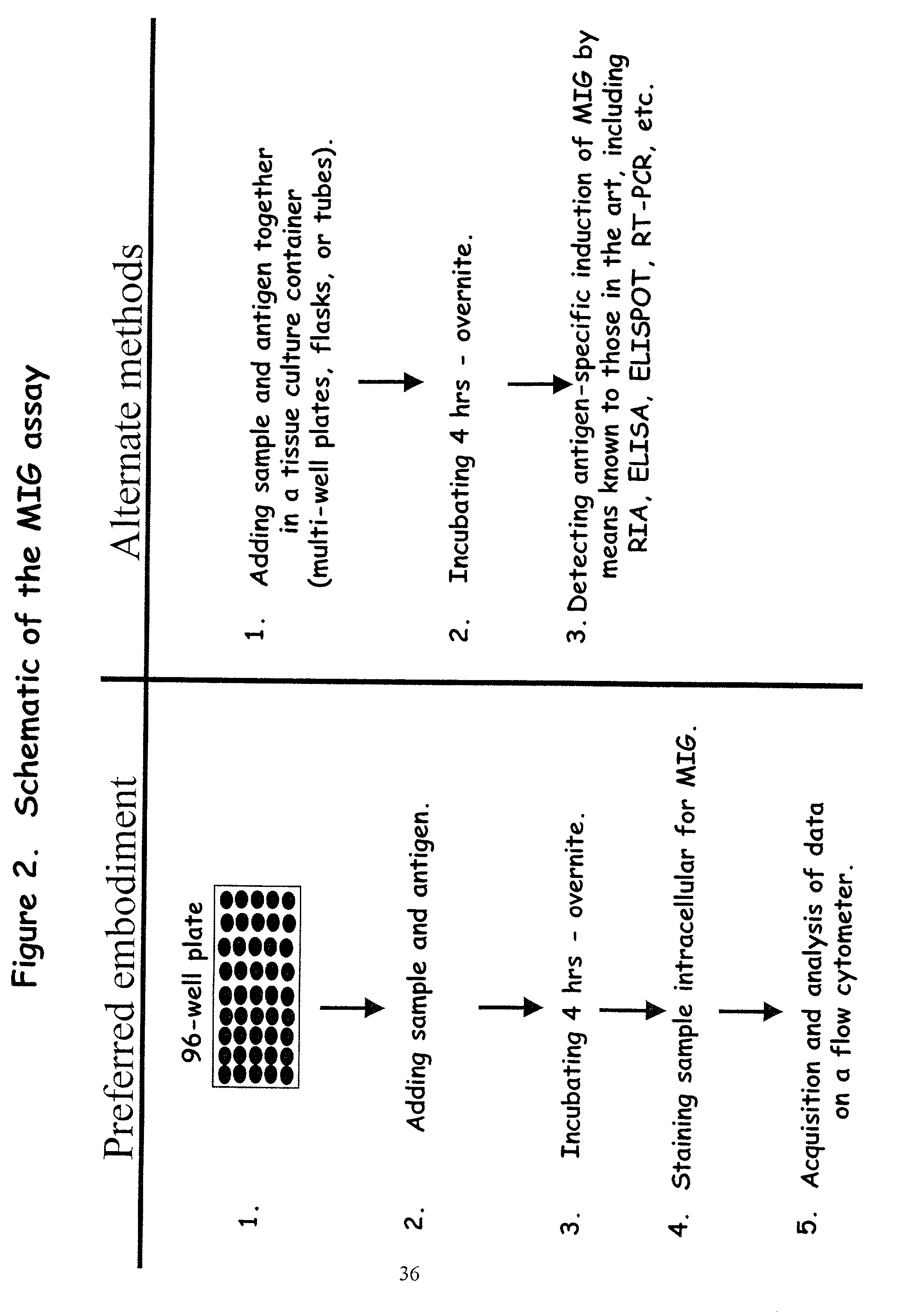Novel assay for detecting immune responses involving antigen specific cytokine and/or antigen specific cytokine secreting T-cells
- Summary
- Abstract
- Description
- Claims
- Application Information
AI Technical Summary
Benefits of technology
Problems solved by technology
Method used
Image
Examples
example 2
[0058] MIG is induced in response to the expression of IFN-.gamma.
[0059] To investigate the profile of chemokines induced following exposure to IFN-.gamma. which could be readily detected by intracellular staining and flow cytometry, PBMC were cultured with recombinant human IFN-.gamma. (rec.hIFN-.gamma.) and stained intracellularly with mAbs to MIG, IP-10, MCP-1, RANTES, or MIP-.alpha.. Expression of both MIG and of IP-10 was readily detectable in PBMC following overnight culture (FIG. 3A). MCP-1 and MIP-1.alpha. expression were slightly upregulated compared to media control but there was no change in expression of RANTES (data not shown). Additional dose titration experiments demonstrated that MIG expression was a more sensitive measure of IFN-.gamma. as compared to IP-10 (FIG. 3B). Moreover, it has been established that the induction of MIG is restricted to IFN-.gamma., whereas IP-10 can be induced by factors other than IFN-.gamma. including IFN-.alpha., IFN-.beta., and LPS (22-2...
example 3
[0060] Induction of MIG expression is antigen-specific and genetically restricted We evaluated whether MIG expression could be induced in an antigen-specific and genetically restricted manner. PMBC from volunteers known to express HLA-A*0201 were cultured with peptides containing HLA-A*0201-binding CD8.sup.+ T cell epitopes derived from HIV, HBV, FLU and CMV. Representative flow cytometric data from one experiment is presented in FIG. 4. MIG expression was detected with PBMC from HLA-A*0201-positive volunteers (Vols. #1,2 and 3) activated with CMV and FLU peptides, but not HIV or HBV peptides indicating that the response was antigen-specific. Additionally, antigen-specific induction of MIG expression was not detected in cultures from volunteers who did not express the HLA-A*0201 allele (Vols. #15 and #16) demonstrating that the antigen-specific response was genetically restricted. These data established that culture of PBMC with synthetic peptides elicited antigen-specific and genet...
example 4
[0061] Induction of MIG expression is IFN-.gamma. dependent
[0062] Having established that rec.hIFN-.gamma. induced MIG expression and that culture of PBMC with synthetic peptides elicited antigen-specific and genetically-restricted MIG expression, we determined whether the induction of MIG expression was dependent on IFN-.gamma.. Accordingly, PBMC were cultured with FLU or CMV peptide in the presence or absence of neutralizing mAbs to IFN-.gamma. or a control mAb (mIgG). Analysis of means and standard deviation of quadruplicate culture and staining wells is shown in FIG. 5. In two volunteers, the addition of neutralizing mAbs to IFN-.gamma. inhibited antigen-specific induction of MIG expression by an average of 87% and 85% to the FLU and CMV peptides, respectively. In repeated experiments with PBMC from volunteers 1-3, the addition of neutralizing antibodies to IFN-.gamma. inhibited antigen-specific induction of MIG expression to both FLU and CMV peptides by 86%, indicating that ant...
PUM
 Login to View More
Login to View More Abstract
Description
Claims
Application Information
 Login to View More
Login to View More - R&D
- Intellectual Property
- Life Sciences
- Materials
- Tech Scout
- Unparalleled Data Quality
- Higher Quality Content
- 60% Fewer Hallucinations
Browse by: Latest US Patents, China's latest patents, Technical Efficacy Thesaurus, Application Domain, Technology Topic, Popular Technical Reports.
© 2025 PatSnap. All rights reserved.Legal|Privacy policy|Modern Slavery Act Transparency Statement|Sitemap|About US| Contact US: help@patsnap.com



